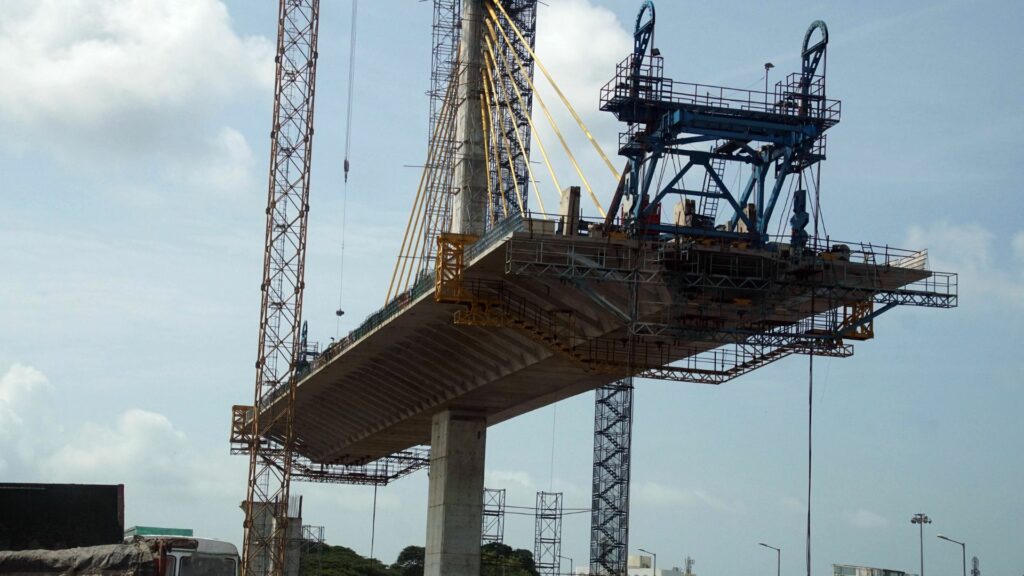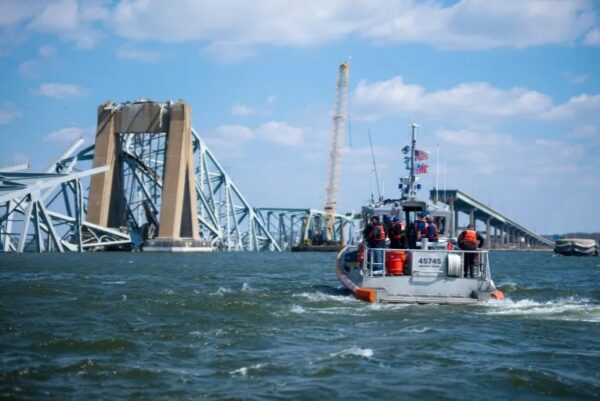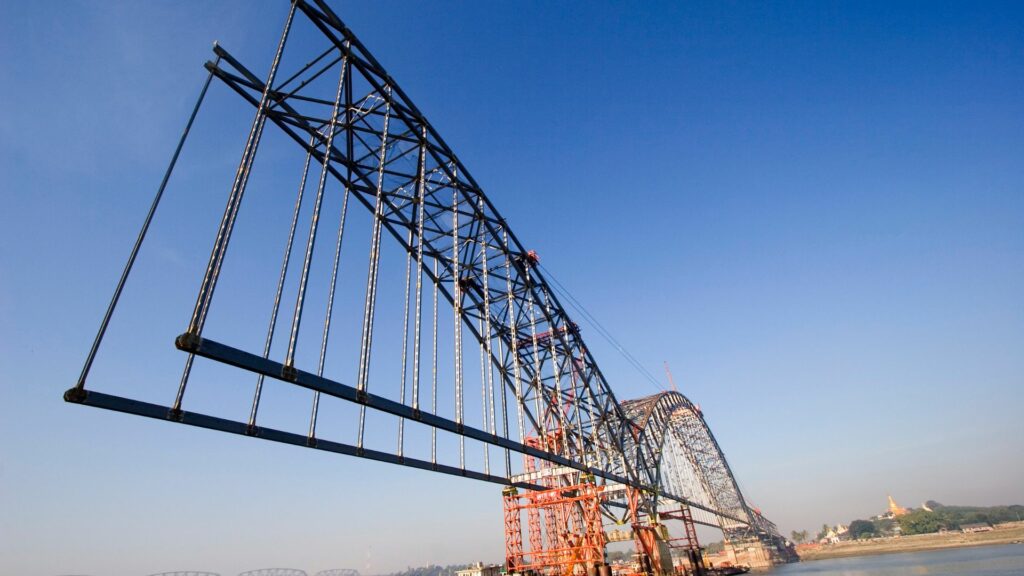The Key Bridge collapse was an accidental tragedy that has shaken public trust in bridge safety. Did you know that over 600,000 bridges in the U.S. are reaching the end of their 50-year lifespans? This blog post will focus on the future and explore how bridge construction is evolving with new technologies and materials to build safer, stronger structures.
Key Takeaways
- New technologies and materials are transforming bridge construction. Carbon fiber offers high strength-to-weight ratio for durable, low-maintenance bridges. 3D printing can create precise bridge components faster with less waste. Smart sensors provide real-time monitoring of bridge health.
- Sustainable and eco-friendly materials like recycled plastic, reclaimed wood, and low-carbon cement are being used in bridge construction to reduce environmental impact while maintaining structural integrity.
- Prefabricated bridge components made in factories allow for faster construction, improved efficiency, and reduced labor and equipment needs on job sites. Advancements in robotics and AI will further optimize bridge design, construction, and maintenance in the future.
Bridge Construction Process

Bridge construction starts with a thorough site inspection and detailed planning. Engineers and construction crews then work to set a strong foundation, install supporting structures like piers, complete the main superstructure with elements like steel beams and concrete slabs, and finally conduct rigorous quality and safety checks before opening the bridge to traffic.
Site Inspection and Planning
Site inspection and planning are crucial for successful bridge construction. Engineers conduct a thorough assessment of the proposed bridge site using advanced technology like ground-penetrating radar and seismic refraction.
They analyze soil conditions, topography, and environmental factors to create a detailed blueprint for the bridge’s foundation and structure.
During this phase, experts use specialized software to simulate various load scenarios and stresses the bridge may face. This allows them to optimize the design for maximum strength and durability while minimizing material costs.
Setting the Foundation
The foundation is a crucial part of any bridge. It supports the entire structure. Crews first excavate the site and pour concrete footings. They then install anchor bolts and rebar to strengthen the foundation.
Precast concrete piles or caissons may be driven deep into the ground for extra stability, especially for bridges over water. The piers that will support the bridge deck are then constructed on top of the foundation.
Specialized equipment like pile drivers and hydro platforms are often used in this phase. Proper curing of the concrete is essential before moving to the next steps. Geotechnical engineers test the soil and ensure the foundation can handle the bridge’s immense weight and forces.
Installing Piers and Bridge Supports
Bridge piers and supports form the sturdy foundation that holds up the bridge deck and spans. Cranes, pile drivers, and excavators are used to drive deep steel or concrete piles into the ground or riverbed.
Cofferdams may be built to create a dry work area for underwater bridge supports. Reinforced concrete is then poured around the piles to shape the piers and abutments.
Plate girders, prestressed concrete beams, or steel trusses are set atop the piers to support the bridge deck. These components are engineered to bear immense loads and withstand the forces of tension and compression.
Completing the Superstructure
After the foundation is set and the piers and supports are installed, the next critical phase is completing the bridge superstructure. The superstructure includes key load-bearing components such as steel or concrete beams, girders, trusses, and the bridge deck.
Skilled contractors carefully place and secure these elements according to the engineering plans, often using cranes and specialized equipment. They use high-strength materials like reinforced concrete and steel alloys to ensure the superstructure can handle immense weights and forces over its lifespan.
Quality control is paramount during superstructure construction. Inspectors check that beams are properly aligned, connections are secure, and the deck is poured and cured correctly.
Final Quality and Safety Inspections
Before opening a new bridge, engineers perform rigorous quality and safety inspections. They use specialized equipment like ground penetrating radar, borescopes, and drones to examine every part of the structure, from the deck and girders to the columns and foundations.
The inspectors look for any signs of damage, corrosion, or defects that could compromise the bridge’s integrity. They also test the load-bearing capacity and ensure all safety features like guardrails and lighting are functioning properly.
Only after passing these thorough inspections is a bridge deemed ready for traffic.
The Impact of the Key Bridge Collapse

image by Aljazeera
Importance of the port of Baltimore for trade
The Port of Baltimore ranks as the ninth largest in the U.S. by trade volume. It serves as a hub for diverse cargo types, including automobiles, machinery, agricultural tools, liquefied natural gas, and sugar. In 2023, the port managed approximately 50 million tonnes of cargo, valued at $80 billion, facilitating trade between the U.S. and various countries. It processed over 847,000 vehicles last year, with around 70% being imports. Furthermore, nearly 20% of U.S. coal exports are shipped from Baltimore. Over 50 ocean shipping and cruise companies operate at the port, making around 1,800 vessel visits annually.
Economic impact of the bridge collapse
Following the collapse of a bridge, U.S. Representative David Trone reported that the port’s closure could drain up to $15 million daily from the economy. The port supports more than 15,000 direct jobs, with an additional 140,000 jobs reliant on its operations. The bridge collapse is poised to significantly affect the insurance sector, with projected claims possibly reaching up to $3 billion. This incident is anticipated to be one of the largest single marine insurance losses.
Diversion of Baltimore-bound ships and cargo
Ships intended for Baltimore are currently on hold, awaiting rerouting to other East Coast ports in the U.S., including Philadelphia, Newark, and Norfolk, among others. While some of Baltimore’s operations remain active east of the bridge collapse, the disruption could slightly extend supply chains, affecting companies like Ford Motor Company, which will need to divert parts to alternate ports.
Repercussions of bridge failure
Bridge failures have far-reaching consequences that go beyond the immediate aftermath. The loss of life, injuries, and property damage are the most devastating impacts. Commuters face delays and disruptions to their daily routines when transportation networks are severed.
Businesses suffer economic losses due to reduced traffic and accessibility.
The financial burden of repairing or replacing a collapsed overpass can be immense. Governments must allocate significant funds from already stretched budgets. Taxpayers often bear the brunt of these costs through increased taxes or reduced services in other areas.
Advancements in Bridge Construction Technology

Advancements in bridge building are making these structures stronger and smarter. New materials like carbon fiber and techniques like 3D printing are changing how bridges are made, while sensors keep a constant eye on their health.
Use of advanced materials such as carbon fiber
Carbon fiber offers an exciting future for bridge construction. This advanced material has a high strength-to-weight ratio. It makes carbon fiber perfect for building durable, low-maintenance bridges.
Beams, girders, and rebars made with carbon fiber are becoming more common. Engineers expect carbon fiber to play a big role in making bridges that last longer and need less upkeep.
Using carbon fiber in bridges helps create stronger infrastructure that’s also better for the environment. This lightweight yet sturdy material opens up new design possibilities for bridges.
Use of 3D printing for bridge components
3D printing offers exciting possibilities for bridge construction. This technology can create specific components like abutments, piers, and footings. Engineers print these parts with concrete, steel, or aluminum.
3D printers precisely shape each piece based on digital blueprints. This method may speed up building times and cut material waste.
3D printing could transform how we make bridges. Robotic systems can work around the clock to fabricate key structural elements. Cranes then hoist and assemble the printed modules at the job site.
Implementation of smart sensors for real-time monitoring
Smart sensors can revolutionize bridge construction by providing real-time monitoring of structural integrity and performance. These advanced devices, such as fiber optic sensors and wireless sensor networks, can be embedded into key components of the bridge, including the deck, girders, and piers.
By continuously collecting data on factors like stress, strain, vibration, and temperature, these sensors enable engineers and contractors to detect potential issues early on, allowing for timely maintenance and repairs.
The integration of smart sensors into bridge construction offers numerous benefits for property managers and contractors alike. Real-time monitoring helps optimize maintenance schedules, reducing costs and extending the lifespan of the structure.
Future Developments in Bridge Construction

Bridge construction is constantly evolving with new technologies and materials. Engineers are exploring the use of carbon fiber, 3D printing, and prefabricated components to build stronger, more durable bridges faster and more efficiently.
Use of sustainable and eco-friendly materials
As the construction industry moves towards a greener future, property managers and contractors are embracing sustainable and eco-friendly materials for bridge construction. Main bridge materials like steel, concrete, stone, asphalt, iron, timber, aluminum, and rubber are being replaced with environmentally conscious alternatives.
These sustainable materials not only reduce the carbon footprint of bridge construction but also ensure long-term durability and reduced maintenance costs.
Innovative materials like recycled plastic, reclaimed wood, and low-carbon cement are gaining popularity in bridge construction. Recycled plastic can be used to create strong and weather-resistant bridge decks, while reclaimed wood from demolished structures can be repurposed for bridge railings and pedestrian walkways.
Incorporation of artificial intelligence and robotics
Artificial intelligence and robotics are transforming bridge construction. AI systems analyze vast amounts of data from sensors embedded in bridges to predict maintenance needs and prevent failures.
Robotic systems automate many construction tasks, from laying foundations to welding steel girders. These technologies boost efficiency, precision and worker safety on bridge projects.
The future of bridge building lies in the seamless integration of AI and robotics. Autonomous robots will handle dangerous jobs like inspections and repairs in hard-to-reach places.
Advancement in prefabricated bridge components for faster construction
Following the integration of AI and robotics, the bridge construction industry is seeing major advancements in prefabricated components. Prefabrication allows for faster construction times and improved efficiency on job sites.
Using factory-made parts like pre-stressed concrete beams, steel girders, and modular deck sections cuts down on labor and equipment needs. It also reduces the environmental impact of construction by minimizing waste and disruption to surrounding areas.
Prefabricated bridge components are set to revolutionize the future of bridge building. Innovations in materials science have led to lighter yet stronger prefab parts that are easier to transport and assemble.
Conclusion
The Key Bridge collapse has renewed the focus on bridge safety and construction practices. Advanced materials, 3D printing, and smart sensors offer promising solutions for stronger, smarter bridges.
Sustainable materials and robotics will shape the future of bridge building. Prefab components can speed up construction timelines. The bridge construction industry must embrace innovation to build safer, more resilient crossings for our communities.
Discover Trusted Contractors with BidSource
For construction manager seeking expertise in bridge construction, BidSource offers a seamless solution. Simply provide us with your project specifics through the form below, and our team will connect you with a skilled contractor ready to tackle your bridge construction requirements.
FAQs
1. What types of bridges are commonly built today?
Some common types of bridges built today include truss bridges, arch bridges, beam bridges, cantilever bridges, cable-stayed bridges and suspension bridges.
2. How can bridge construction be made safer in the future?
Future bridge construction can be made safer by using stronger materials like reinforced concrete, prestressing steel, post-tensioning tendons, and incorporating I-beams or reinforcing bars for added support.
3. Are there alternatives to traditional bridge designs?
Yes, alternatives to traditional bridge designs include stone arch bridges, cable-supported bridges, and newer web-based designs that use less material but provide the same strength.
4. What caused the collapse of the Francis Scott Key Bridge?
The collapse of the Francis Scott Key Bridge in Baltimore was caused by a large cargo ship, the MV Dali, which struck the bridge after experiencing a complete power outage.
5. How will this incident impact future bridge and road construction projects?
The Key Bridge collapse will lead to stricter safety regulations and inspection protocols for future bridge and road construction projects overseen by agencies like PennDOT. This may mean increased costs for equipment rentals and longer construction times to ensure public safety.
6. Where can I find more information about bridge construction and safety?
For more information on bridge construction and safety, consult government transportation websites or industry resources that provide up-to-date data and analysis. Look for pages with clear navigation menus and working hyperlinks to ensure you’re getting accurate information.

Aaron Hockel is a Partner and the VP of Digital Marketing at AltaVista Strategic Partners. A University of Maryland, Baltimore County (UMBC) alumnus, Aaron expertly crafts digital marketing strategies that drive success for clients, leveraging his deep industry knowledge and innovative approach.


